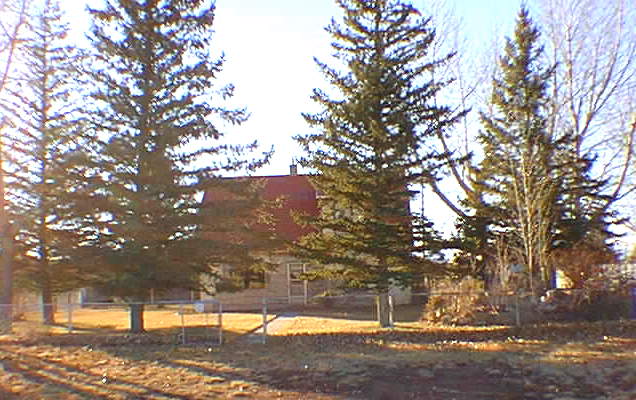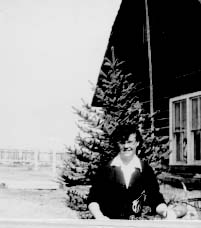
| This 1900 home was brought down from Bunch Gluver's place on South Piney for Dr. and Mrs. Brain. The first records the county has is that Curtises owned a large area of land which included this lot. Lillian Curtis married Bill Milleg and they are the grandparents of Bill Milleg and Darlene Holgate. Ray and Nettie Daniels lived here for a time. Spike Daniels was born in this house. In 1939 the Curtises sold this home to Bill and Opal Ray. They had a tremendous job fixing it up as it had been empty for a time and the Civilian Conservation Corp had a camp just to the west. Opal even built kitchen cupboards which are still there. In 1990 their children sold it to Mike and Bobbi Wade. |

|
Our parents bought the shell of the house and about four acres of land from John Curtis for something like $600. It had neither plumbing nor electricity. Sandra Milleg told us that the house had been owned by a doctor, and that it had been moved to its present location from a nearby ranch. I remember many good times we had with friends and family in that house. There were two boys and three girls all still living: William Arthur of Texas in the winter and Denver in the summer, Betty Alferna of Cheyenne, Maicille Carr of Texas and Big Piney, Marilyn Vickrey of Big Piney, and Donald Wayne of Slidell, Louisiana. It was not unusual for us to bring three or four friends to spend the night. The house at that time had three bedrooms, one on the first floor and two upstairs. The two boys shared one room and the three girls shared the other, although our older brother Bill went into the service in 1943, so didn't live there for long. I don't remember where we slept, but sleeping was not a top priority in those days. The house had no indoor plumbing. That came sometime after I was married in 1951. And yes, we did put our tongues on the pump handle on cold days to see if they would stick! I recall taking a bath in a galvanized wash tub upstairs on the morning of my wedding. (We usually bathed downstairs, but on that day, we were expecting guests for a reception after the wedding held at the Congregational Church.) Our mom rebuilt that house almost singlehandedly. She told us about having to clean up the feces that had been deposited there by young men from the CCC camp which was located where Enron Petroleum is now. When we first moved there, there were four square rooms downstairs with the stairway opening into the small living room. My parents had the stairs turned around so they opened off the kitchen downstairs and between the two bedrooms upstairs. It had been wallpapered mainly with old newspapers. I remember that the "dobbing" had fallen from the cracks (wide ones) between the logs, and willow strips nailed on each log helped new "dobbing" made with a concrete mixture stay in place. The kitchen had no cabinets, and Mother cleverly blended together several old pieces of cabinets and cupboards and covered them with linoleum. Those were still there when my four brothers and sisters sold the house to Mike and Bobbi Wade after our parents' death. Wallpaper was the solution for old, crooked walls. (My dad was horrified when I told him I planned to wallpaper the walls in our new house!) And of course there was a coal stove to cook on and to provide heat. Those bedrooms upstairs had no heat and we dressed mighty quickly on cold mornings! A telephone was unheard of. |
| Sources: | County records
Bob Thompson Marilyn Vickrey Maicille Carr |